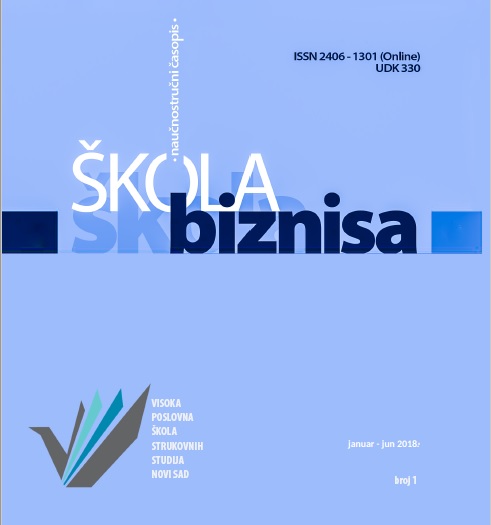THE NEW SILK ROAD: THE EUROPEAN UNION, CHINA AND THE FUTURE OF TRADE
Abstract
Transport costs are one of the crucial factors that shape the world trade patterns. In order to promote transport facilitation and to create an environment for a more efficient flow of goods Chinese government launched the New Silk Road initiative in 2013. One major issue that has an impact on transport, and consequently on the future development of the initiative, is the growing trade flow between China and the European Union. An interesting fact, clearly indicated, about China is that the nation will become the world’s largest middle-class market in the next decades. The recent Chinese demographic transformation –the rise of middle class consumers- is expected to have critical dynamics for the relations between China and the European Union. With growing purchasing power and more European brand preferences, China’s middle income consumers are an obvious future target market for EU brands.
References
Amighini, A. (2017). Towards a New Geography of Trade? In A. Amighini (Eds.) China’s Belt and Road: a Game Changer?, Milan: The Italian Institute for International Political Studies (ISPI).
Behar, A. & Venables, A. J. (2010). Transport Costs and International Trade. Economics Series Working Papers 488, University of Oxford, Department of Economics.
Barton, D. (2013). The Rise of the Middle Class in China and Its Impact on the Chinese and World Economies. In China-United States Exchange Foundation (Eds.), US-China Economic Relations in the Next 10 Years: Towards Deeper Engagement and Mutual Benefit. Chapter 7, 138-148.
Barton, D., Chen, Y. & Jin, A. (2013). Mapping China’s Middle Class, McKinsey Quarterly, June.
Bernstein, W. J. (2008). A Splendid Exchange: How Trade Shaped the World. New York: Atlantic Monthly Press.
Bolle, M. & Kortsari, A. (2014). Europe-Asia Railway Transport: Issues and Prospects, Project NEAR², 7th Framework Programme, Grant Agreement No: 314254.
Chunrong, L. (2016). The Rise of a Middle-Class Society and its Implication for China-EU Relations. In S. Islam (Eds.), EU-CHINA Relations Discussion Paper New Directions, New Priorities, Discussion Paper, Friends of Europe.
Deepak, B. R. (2018). China's Global Rebalancing and the New Silk Road. Singapore: Springer.
Derudder, B., Liu, X. & Kunaka, C. (2018). Connectivity along Overland Corridors of the Belt and Road Initiative. MTI Global Practice Discussion Paper, No. 6. Washington, DC: World Bank.
European Commission (2018) European Union, Trade in Goods with China, Directorate-General for Trade.
Eurostat (2018) International Trade in Goods – A Statistical Picture, International Trade - Statistical Publications, October 30.
Eurostat Statistics, Extra-EU Trade by Partner, Available at https://ec.europa.eu/eurostat
Eurostat Statistics, Extra-EU Trade by Mode of Transport, Available at https://ec.europa.eu/eurostat
Guluzian, C.R. (2017). Making Inroads: China’s New Silk Road Initiative, Cato Journal, Vol. 37, No. 1, Winter.
Hansen, V. (2012). The Silk Road: A New History. London: Oxford University Press.
Herrero, A. G. & Xu, J. (2016). China’s Belt and Road Initiative: Can Europe Expect Trade Gains?, Bruegel Working Paper, Issue 5.
Herrero, A. G., Kwok, K. C., Xiangdong, L., Summers, T. & Yansheng, Z. (2017). EU–China economic relations to 2025: Building a Common Future. Joint Report by Bruegel, Chatham House, China Center for International Economic Exchanges and The Chinese University of Hong Kong. London: The Royal Institute of International Affairs.
Holslag, J. (2017). How China’s New Silk Road Threatens European Trade. The International Spectator: Italian Journal of International Affairs, 52(1), 46-60.
Islam, M. & Subran, L. (2017). Will the Chinese Consumer Save the World?, Allianz Euler Hermes Economic Insight, July 31.
Jovanovic, M.N., Damnjanovic, J. & Njegic, J. (2018). Euro-Asian Overland Transport Links: Prospects and Challenges, Handbook of International Trade and Transportation (eds. B. Blonigen and W. Wilson) Cheltenham: Edward Elgar, 602-627.
Kharas, H. (2017). “The Unprecedented Expansion of the Global Middle Class: An Update” Global Economy and Development, Working Paper 100. Washington, DC: Brookings Institution.
Konings, J. (2018). Trade Implications of the Belt and Road Initiative, ING Think Economics and Financial Analysis, 6 June, Amsterdam.
Leer, Y. & Yau, J. (2016). China’s New Silk Route the Long and Winding Road. 1st edition, PwC's Growth Markets Centre, February.
Li, Y., Bolton, K. & Westphal, T. (2016). “The Effect of the New Silk Road Railways on Aggregate Trade Volumes between China and Europe”, Institute of East Asia Studies Working Paper, No.109, Universität Duisburg Essen.
Office of the Leading Group for the Belt and Road
Silk Road Finance Cooperation, Belt and Road, Available at www.silkroad-finance.com/en/belt-road/
Starr, S.F, Cornell, S.E., & Norling, N. (2015). The EU, Central Asia, and the Development of Continental Transport and Trade, Silk Road Paper, Singapore: Central Asia-Caucasus Institute & Silk Road Studies Program.
The Economist (2014). China's Addiction to Luxury Goods, April 30th.
The Economist (2017). New Rail Routes between China and Europe will Change Trade Patterns, September 16th.
Wood, F. (2002). The Silk Road: Two Thousand Years in the Heart of Asia, Berkley: University of California Press.
World Bank, World Development Indicators: Structure of Merchandise Exports.
Zimmerman, T. (2015). The New Silk Roads: China, the U.S., and the Future of Central Asia. New York: Center on International Cooperation, 1-26.
- Authors retain copyright and grant the journal right of first publication with the work simultaneously licensed under a Creative Commons Attribution License that allows others to share the work with an acknowledgement of the work's authorship and initial publication in this journal.
- Authors are able to enter into separate, additional contractual arrangements for the non-exclusive distribution of the journal's published version of the work (e.g., post it to an institutional repository or publish it in a book), with an acknowledgement of its initial publication in this journal.
- Authors are permitted and encouraged to post their work online (e.g., in institutional repositories or on their website) prior to and during the submission process, as it can lead to productive exchanges, as well as earlier and greater citation of published work (See The Effect of Open Access).

